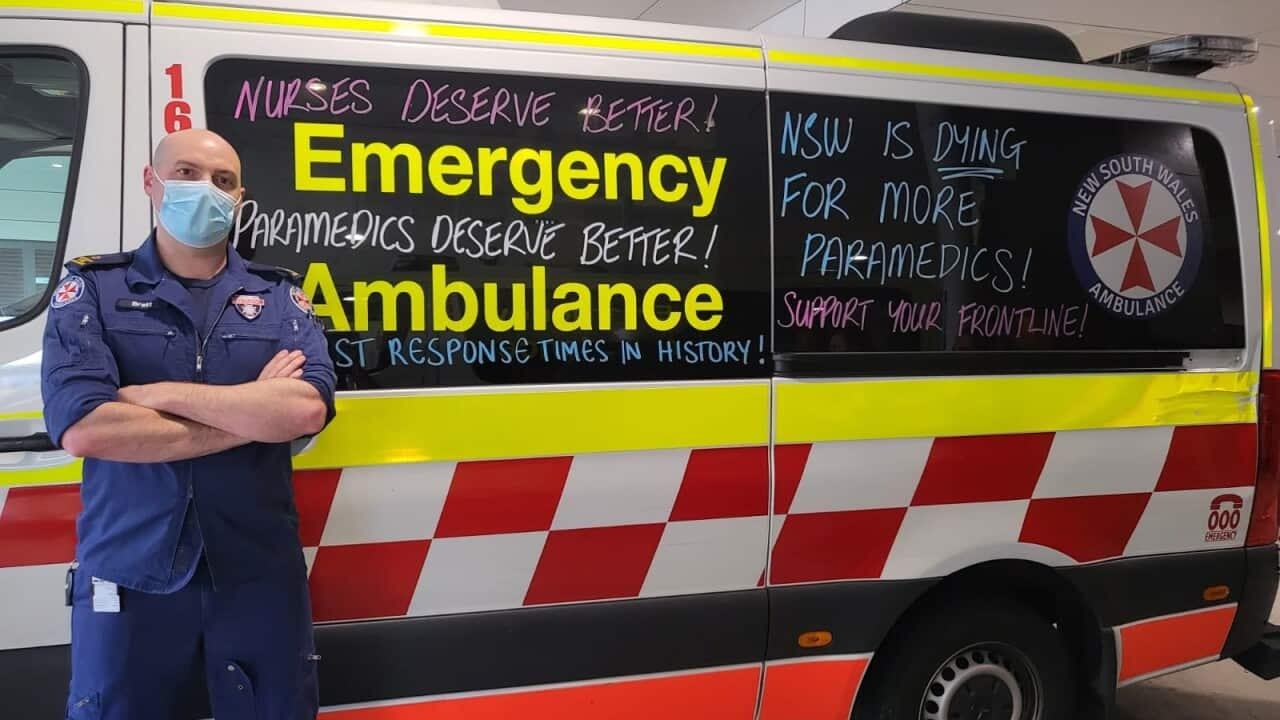Every day, intensive care paramedic Brett Simpson heads to work weighed down with the possibility that a patient might die because he couldn't get to them on time.
Based in NSW, Mr Simpson has been working as a paramedic for over 13 years - but he has never seen the state of NSW's healthcare system at such crisis levels.
Across Australia, paramedics have been inundated with unprecedented levels of triple-zero calls, forcing people to wait several hours at home before an ambulance reaches them.
Ambulances in NSW responded to a record-high of 116,000 calls in April alone, compared to 281,400 calls in 2018 before the COVID-19 pandemic.
For some patients, those hours can mean life or death.
"We literally have patients dying and waiting for ambulances or having serious, harmful outcomes waiting for paramedics to reach them," Mr Simpson, a union delegate for the Australian Paramedics Association, told SBS News.

Paramedics in NSW have written messages of protest across their ambulance vans ahead of the industrial action launched across the next five days. Source: Supplied / Brett Simpson
"It's crippling as clinicians who all we want to do is just be able to do our best for our patients. And it's just becoming impossible because we know that, increasingly, we're not going to get to these people in time."
But even when patients are driven to hospital, they then face huge backlogs called "bed blocks" or "ambulance ramping".
These terms refer to when paramedics are forced to wait idly in parking bays at hospitals because there aren't enough free beds for incoming patients.
A string of recent deaths in Victoria, NSW, WA, South Australia and Tasmania have been linked to ambulance delays, prompting anger and frustration from grieving family members and paramedics.
It is a nationwide crisis that ambulance unions say paramedics have experienced for decades.
But Mr Simpson says since the COVID-19 outbreaks, what was initially thought to be "cracks in the system" turned out to expose "giant chasms" in the healthcare workforce.

NSW is facing significant bed block problems, where hospitals do not have enough beds for incoming patients. They are forced to stay in ambulance vans for hours until there is capacity in the hospital. Source: Supplied / Brett Simpson
"This is a clear indication that our hospitals are in crisis," the report said.
Most states and territories had a target to transfer 90 per cent patients into care within 30-40 minutes, with none able to achieve that goal.
Ambulance ramping emerged as a major issue in the South Australian election in March, with the AMA report card showing it was only able to transfer 54.1 per cent of patients within 30 minutes in 2020-21.

A report on ambulance ramping by the Australian Medical Association shows none of the Australian jurisdictions were able to meet their set targets. Credit: Australian Medical Association
Code Red dilemma in Victoria the tipping point
On Friday night, Victorian health authorities declared a Code Red emergency after a technical error forced their ambulance system to crash.
According to Victoria's ambulance union secretary Danny Hill, 70 people required urgent medical help but there was no ambulance available to reach them.
"Code Red is the highest level of escalation strategy and at the state health emergency response plan. So we would normally only see that in events like thunderstorm asthma, or a bushfire," Mr Hill said.
The dispatch system used by the Emergency Services Telecommunications Authority [ESTA] usually pinpoints the nearest available ambulance to send to a medical emergency.
When it crashes, call-takers have to resort to a pen and paper-type system with crews manually calling in their locations over radios, Mr Hill said.
The fault was resolved within 30 minutes, but it has put paramedics on edge after a medium-level emergency code, Code Orange, days prior as well as earlier this month.
The IT glitch occurred in the midst of enormous demand and resulted in the Code Red for up to two hours, senior state minister Martin Pakula said.
Mr Pakula spruiked the government's pledge to recruit and train 400 ESTA staff as part of a $333 million budget spend after a review found "continued and systematic underperformance".
Spike in triple-zero calls exhausting healthcare workers
Mr Hill said the uptick of triple-zero calls is because people are calling for incidents that are not deemed emergencies.
"We're not seeing an increase in heart attack strokes or car accidents. It's an increased reliance on ambulance services and on emergency departments, that's overwhelming the system," he said.
Ambulance Victoria experienced its busiest quarter in history from January to March and the pressure has left staff burnt out and exhausted.
"They've been working through the pandemic, we were busy before the pandemic, and now we're just seeing these Code Orange and Code Red events happen far too frequently," he said.
"[We're feeling] exasperation, fatigue, the crews are just exhausted, absolutely exhausted."
Mr Hill has called on Australians to visit their family doctor as soon as they feel unwell to avoid a late emergency that will overwhelm the strained healthcare system.
"The system just isn't big enough and none of the systems in Australia are big enough to cope with the overwhelming demand at the moment.
"They've got the worst ambulance ramping in Australia happening in Queensland at the moment. South Australia, Tasmania, WA, they're all dealing with it as well."
NSW paramedics take snap industrial action
Paramedics across NSW have started to refuse to take patients' billing details over the next five days as they launched their snap industrial action on Friday.
It was due to begin on Monday, but paramedics brought forward the industrial action after the government launched a challenge in the Industrial Relations Commission (IRC).
Paramedics have stopped taking patients' billing details, will not report key performance indicators and will not accept call-outs to external stations.
"We feel that with the sad and sorry state of the ambulance service at the moment, it's unacceptable for patients to be given bills worth hundreds of dollars when they've had to wait - and potentially suffered harm - because of the resourcing crisis," Mr Simpson said.
NSW Premier Dominic Perrottet said on Friday that further funding would be committed to paramedics in the June budget.
"[That funding is] incredibly important because they do an amazing job on our front line every single day," he said.
He urged people to call an ambulance only in an emergency.
"What we're seeing more and more of now is that people are calling triple zero in times where there's not an emergency at hand," Mr Perrottet said.
"And we want obviously our emergency departments to be there for real emergencies."
The Australian Paramedics Association is calling on the government to commit to further funding for specialists and community care, to increase paramedic staff numbers by at least 1500, and to lift paramedics' wages.
The IRC will hear the matter on Monday.
With AAP.












